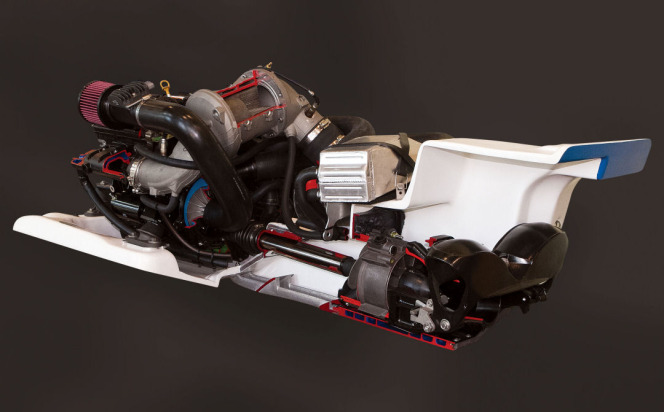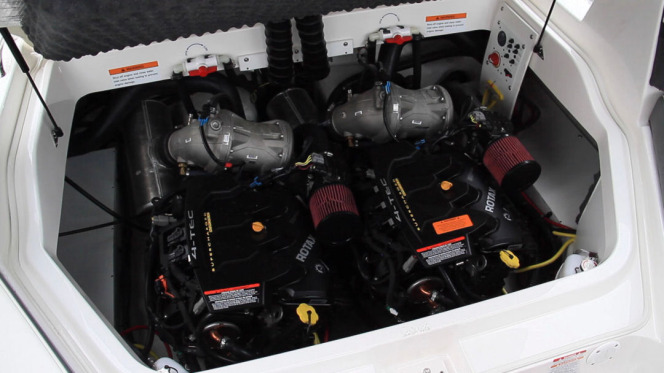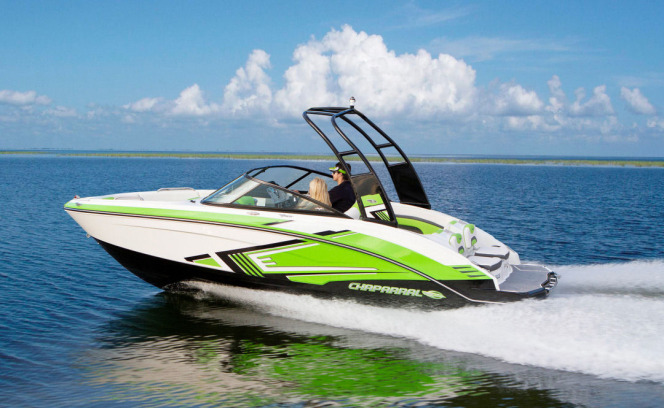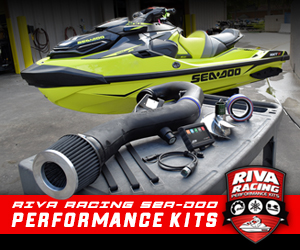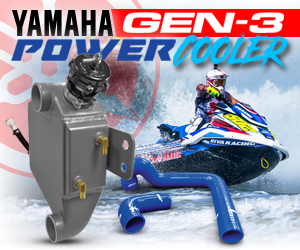Want to know the surefire way to cause a riot on a personal watercraft performance webforum? Threaten additional governmental intrusion on their horsepower. That’s what happened over this past weekend at Greenhulk.net. With the posting of a single image grabbed with a cellphone, PWC enthusiasts went rabid howling vengeance against purposed increased emission standards, boating safety standards and anyone driving a Prius (OK, maybe it wasn’t that bad).
 Nevertheless, the image in question did raise several eyebrows that required some earnest investigation. The note we received from Greenhulk’s own Jerry Gaddis was innocent enough, “Here’s a Rotax engine in a Chaparral jet boat. Notice the wet catalytic converter. I wonder if we will see this on future PWCs? [Also] notice it also has an 02 sensor.”
Nevertheless, the image in question did raise several eyebrows that required some earnest investigation. The note we received from Greenhulk’s own Jerry Gaddis was innocent enough, “Here’s a Rotax engine in a Chaparral jet boat. Notice the wet catalytic converter. I wonder if we will see this on future PWCs? [Also] notice it also has an 02 sensor.”
For those unclear what a catalytic converter does, let’s back up. A catalytic converter (or “cat”) is commonly found on automobiles dating back to the early 1970s between the exhaust manifold and muffler. The muffler-like chamber houses a ceramic honeycomb (or ceramic beads) coated with platinum and palladium, the catalyst that converts the hydrocarbons into carbon dioxide and water, and the nitrogen oxides into nitrogen and oxygen.
Previous iterations of the catalytic converter were indirectly responsible for notable losses in performance, but coincided with an across-the-board shift in manufacturers producing high-performance vehicles. The addition of recirculating air/exhaust systems, lower compression rates, gentler cam lobe profiles and cubic displacements only worsened the landscape. Fatefully, catalytic converters were singled out for robbing horsepower, thereby hailed as blight to performance vehicles.
So when the image of a water-jacketed catalytic converter seen interrupting the exhaust from a Rotax 4-tec to the waterbox was published on the Internet’s most popular PWC performance forum, people started to worry what this meant for future watercraft? Did Sea-Doo know of pending future emission standards requiring the additional converter? Would it rob power? How much would it weigh? Does it mean we would need to “smog check” future personal watercraft?
Our first clue was that Jerry mentioned it was on a Chaparral jet boat. We immediately went to the official Chaparral website which proudly featured the catalytic converter stating, “We’re dedicated to respecting the environment and minimizing the effect that our powertrains have on it. With legislative requirements in mind, BRP developed a marine exhaust gas after-treatment system with a ‘3-way catalytic converter.’ This unique system fulfills the 5g CO + NOx within a nominal power of 260 HP.”
This “3-way” converter meets the current “4-star” emissions standard that Rotax is very proud to announce. Hailed as part of the company’s “social responsibility,” Rotax writes, “Our success is not only measured by the performance of our products. It’s measured by our actions as a corporate citizen. For the environment, it all begins with reducing the carbon footprint of all of our products and operations, guaranteeing compliance and leading the way for industry. We achieve this by continually reducing fuel consumption, exhaust emissions and noise.
“In fact, whatever the product, BRP manufactures some of the powersports world’s cleanest and quietest engines. In the community, BRP prides itself in being an active member and advocate for the communities within which we live and work. As a multinational company, it’s our responsibility to ensure that our presence is beneficial to the communities where we are located. What’s more, we make it our mission to support education and training to encourage responsible use of our products.”
While this might sound like very pleasant marketing boilerplate, it does speak to Rotax’s commitment to compliance to both governmental, environmental and social standards. But, what all of that didn’t do was clarify whether we’ll be seeing Sea-Doos with big honkin’ catalytic converters crammed under our seats. For that, we turned to LOOK Marketing and Sea-Doo representative, Tim McKercher who happily shed some more light on the subject:
“Jetboats now fall under the CARB & EPA Inboard/Sterndrive standard. Their current “4-Star” level is 5 g/kW-hr of Hydrocarbon (HC) and Oxides of Nitrogen (NOx). Meeting that requires a catalyst.
“PWCs are not classified as Inboard or Sterndrive boats. Jet boats used to be classified under the PWC standard, but that changed a couple of years ago. These Rotax propulsion packages are also utilized in Scarab and Glastron boats from RBH (Rec Boat Holdings).”
Whew! Well, it sounds like we have our answer. But that is not to say that Rotax’s 3-Way Catalytic Converter will never be found inside of a Sea-Doo. Environmentalists are always biting at the heels of PWC and as long as we have proper representatives lobbying to retain some sense of preservation for watercraft we should be in the clear. Thankfully, today’s PWC have never been more environmentally-friendly, clean, quiet and safe (all the while producing more horsepower and fun) than ever before.




